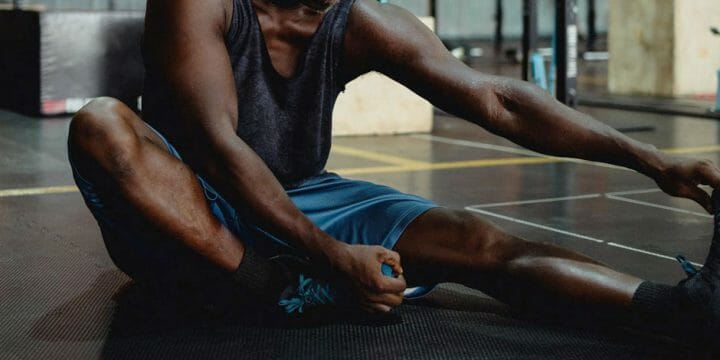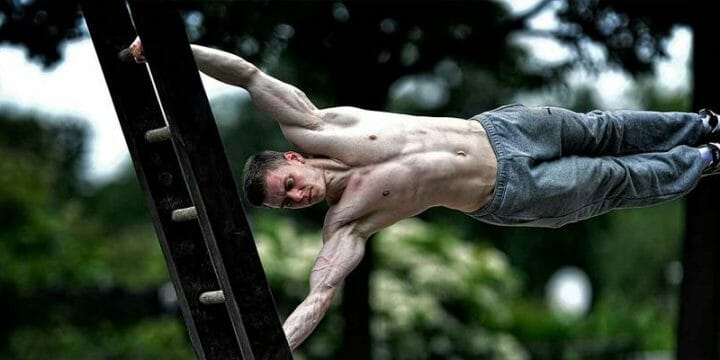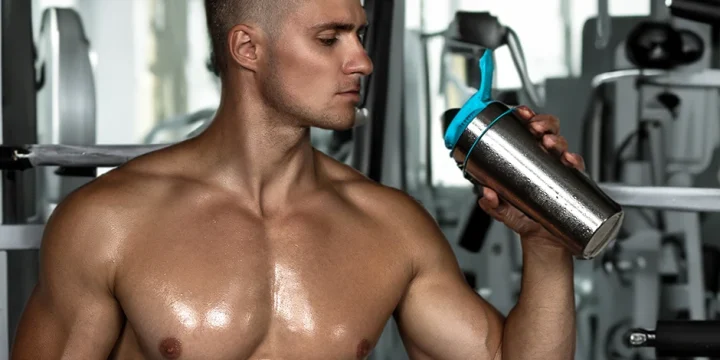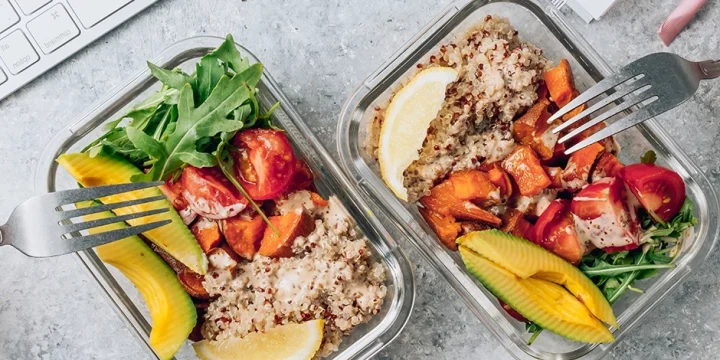The quadriceps, comprising four major muscles, are among the most powerful in the lower body.
Targeting all four effectively requires diverse motions, equipment, and stances.
Drawing on extensive experience and rigorous testing of over 40 exercises, we've compiled the top 10 quad exercises for optimal strength and hypertrophy.
Read on to discover these exercises, their correct execution, benefits, warm-ups, and more, including a guide to selecting the best barbell for your home gym.
Also, check out our guide on recommended barbell for your home gym to choose a high-quality and durable barbell that will last you for ages.
Quick Summary
- The top quad exercises for building muscle and strength include ones like front squats, heels-elevated goblet squats, sissy squats, etc.
- Diverse exercises, equipment, and stances are necessary to effectively target all four quadriceps muscles.
- A 2013 study in 'Osteoarthritis and Cartilage' revealed a 28% higher risk of worsening knee pain in women with weaker quads, highlighting the importance of quad strength.
- In my opinion, adding these quad exercises to your training is key to boosting both sports performance and functional strength in daily activities.
The 10 Best Quad Exercises for Building Muscle

My team and I tested all the quad exercises from the list below to ensure they were safe and beginner-friendly.
We selected all exercises based on the criteria of strength and hypertrophy development.
Echoing a study from the International Journal of Environmental Research and Public Health, I always recommend dynamic warm-ups before quad sessions to prevent injury and enhance performance [1].
Read below to learn about the 10 best quad exercises for maximal muscle-building effects.
"A well-rounded leg workout should include exercises that specifically target all four muscles of the quadriceps."
- Tara Laferrara, Certified NASM Personal Trainer
1. Front Squats
Front squats are one of the best exercises for building quadriceps muscles and are a variation of traditional back squats.
The barbell placed in front of the body’s center will shift the weight forward, activating your quads more due to increased bending in the knee joint.
The front squat is a compound exercise that activates large muscle groups and uses multiple joints to complete the movement.
How to Perform Front Squats:
- Load the barbell on the squat rack for 8 reps.
- Grip shoulder-width, barbell on collarbone.
- Elbows at 90 degrees, fingers supporting the barbell.
- Stand shoulder-width apart, knees aligned with toes.
- Bend hips, knees, and ankles to squat, with thighs parallel to the ground.
- Hold for a second, then stand up.
- Repeat for 10 reps, 3 sets.
2. Heels Elevated Goblet Squats
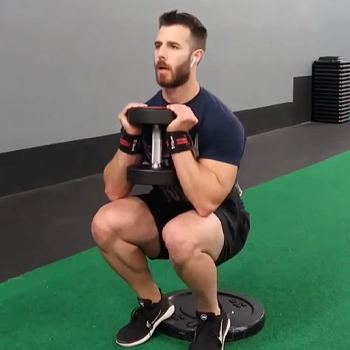
Heels-elevated goblet squats are among the best leg exercises targeting all four quad muscles with dumbbells.
Heels elevated goblet squat is performed with kettlebells or dumbbells and is similar to the barbell front squat.
How to Perform Heels Elevated Goblet Squats:
- Stand shoulder-width, select dumbbell or kettlebell for 12 reps.
- Hold weight at chest, heels on weight plate.
- Squat down, back flat, knees aligned with toes.
- Thighs parallel to the ground; hold for a second.
- Stand up, repeat for 12 reps, 3 sets.
3. Rear Foot Elevated Split Squats
Having incorporated rear foot elevated split squats in many training programs, I can attest to their effectiveness in building glutes, hams, and quads.
Rear foot elevated split squat is easy to progress since the loading of only one leg will increase quad, glute, and hamstring activation, making the hypertrophy element easier to achieve.
How to Perform Rear Foot Elevated Split Squats:
- Hold dumbbells and place one leg on the bench.
- Forward foot steps out, back straight.
- Lower down, bending your forward foot.
- Hold the bottom position for 1-2 seconds.
- Stand up, repeat for 6 reps per leg, 3 sets.
4. Seated Dumbbell Leg Extensions
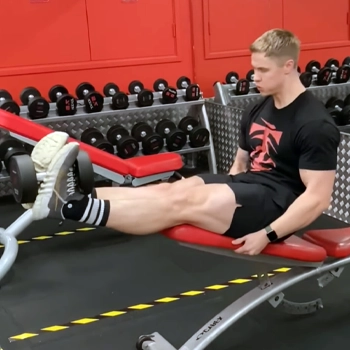
Based on our observations, seated dumbbell leg extensions offer a more functional approach compared to machine leg extensions.
It will force core activation and develop balance in the seated position with a limited surface.
How to Perform Seated Dumbbell Leg Extensions:
- Choose dumbbell for 12 reps.
- Sit on the bench, dumbbell between feet.
- Extend legs; bend knees to lower.
- Feet just above ground, then extend.
- Repeat for 12 reps, 3–4 sets.
5. Sissy Squat
The sissy squat is a challenging squat variation that targets the quads by leaning your body backward, making bending forward in the knees necessary.
It can represent a problem with weak knees since your knees and going past the toes create tension in the joint.
If you are a beginner, you can still do sissy squats since they are performed with just your body weight, but for 2 sets and 8 reps.
How to Perform a Sissy Squat:
- Stand in front of the squat rack for balance.
- Hold rack; rise on toes.
- Lower into a squat, torso back, knees forward.
- Reverse motion at the balance limit.
- Repeat for 8 reps, 3 sets (if your knees are healthy).
6. Banded Spanish Squats
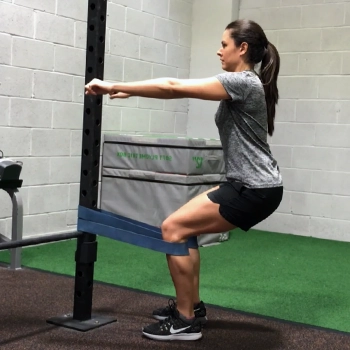
As a coach, I often recommend banded Spanish squats; they perfectly position your hips to maximize quad engagement.
The most bending will occur at your knee joint, making your quads tenser.
How to Perform Banded Spanish Squats:
- Loop resistance bands around the squat rack.
- Stand in bands behind your knees.
- Step back and tighten the bands.
- Squat down, back flat, hips at 90 degrees.
- Thighs parallel to floor, then stand.
- Repeat for 8 reps, 3 sets.
7. Front Foot Elevated Reverse Lunges
Front foot elevated reverse lunges are excellent split squat variations targeting your vastus medialis, vastus lateralis, vastus intermedius, and rectus femoris.
They are also effective at working the stabilizers necessary to keep your body balanced during any movement.
How to Perform Front Foot Elevated Reverse Lunges:
- Hold dumbbells, foot on an elevated surface.
- Lower into a split squat, thigh parallel to floor.
- Hold for a second, then stand.
- Repeat for 8 reps per leg, 3 sets.
8. Sitting Leg Extensions
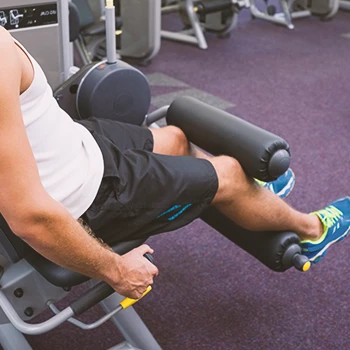
Sitting leg extensions are machine leg extensions.
They are the least functional exercise on the list but they are effective for inducing quad hypertrophy.
How to Perform Sitting Leg Extensions:
- Set the weight on the machine for 12 reps.
- Sit and hold the side bars.
- Extend your knees and hold the top position.
- Flex knees to lower; repeat for 12 reps, 3 sets.
9. Dumbbell Hack Squat With a Foam Roller
From my coaching, I've seen that dumbbell hack squats with a foam roller can be challenging for beginners.
However, it is one of the most effective knee extension exercises, targeting all quadriceps muscles.
How to Perform Dumbbell Hack Squats With a Foam Roller:
- Place dumbbells near the wall and a foam roller on the wall.
- Stand with foam roller on back, dumbbells in your hands.
- Squat down; foam roller aids movement.
- Thighs parallel to ground, then stand.
- Repeat for 8 reps, 3–4 sets.
10. Pistol Squats
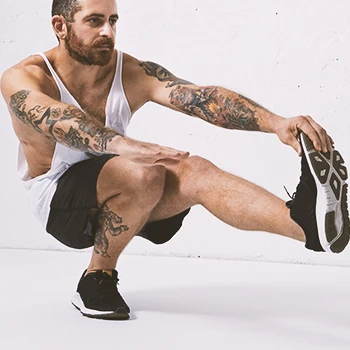
Through my training sessions, I've observed that pistol squats are outstanding for strengthening the glutes, hamstrings, and quads unilaterally.
However, they will also build lower-body dynamic stability essential for team sports such as basketball, football, hockey, etc.
How to Perform Pistol Squats:
- Stand and lift one foot.
- Bend the standing leg into a squat.
- Extend the other knee as you lower.
- Deep squat, then rise.
- Repeat for 6 reps per leg, 3 sets.
3 Benefits of Training Your Quads

Strong quads are crucial for maintaining a healthy knee joint and a functional lower body.
Yet, a sedentary lifestyle, particularly prolonged sitting, can lead to weakened quadriceps muscles. A 2013 study published in the 'Osteoarthritis and Cartilage' journal revealed that women with the weakest quad muscles faced a 28% higher risk of escalating knee pain, underscoring the importance of quad strength [2].
So, strengthening your quads can decrease the chance of ankle, knee, and hip injuries.
Below, you may find the most notable quad training benefits.
1. You’ll Improve Your Bigger Lifts
If you strengthen your quads, you will improve all your 1RM (1 repetition maximum) from lower body exercises, including knee bending.
Quads are the strongest knee extensors; that’s why having strong quads is essential for improving all major lifts consisting of knee bending.
This counts for both lower-body compound bilateral and unilateral exercises.
However, it also counts for the isolation exercises.
Strengthening your quads will increase the 1RM of exercises such as the back squat, front squat, deadlift, rear foot elevated split squat, single leg squat, pistol squat, sissy squat, and more.
2. You’ll Be Less Prone to Injury
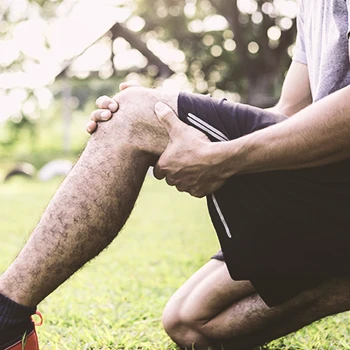
Reflecting on a 2009 study from Arthritis and Rheumatism and my own coaching observations, strong quads are linked to a lower risk of lower body injuries [3].
By strengthening your quads, you will also lower the chance of injury associated with the hip, knee, and ankle joints.
Weak quads can make your body compensate with muscles above and below the knee joint.
This places much more stress on the ankle and hip joints, making them more prone to injury.
Strong quads will also improve the stability of your knee joint, decreasing the chance of ACL (anterior cruciate ligament) injuries, torsions, and ruptures.
"The quad muscles give strength and structure to the lower body and help protect the knee and hip."
- Jake Boly, Certified Strength & Conditioning Specialist
However, keep in mind that overemphasis on the quads can also lead to muscular imbalances so strive to maintain a balance between quad and hamstring strength.
3. Quad Training Can Keep You Moving
Your quads are crucial for everyday activities like walking and climbing stairs and engaging in key movements during these actions, as a study from the Journal of Biomechanics shows [4].
Strengthening your quads not only improves efficiency in daily tasks but also boosts endurance for cardio exercises.
This is particularly beneficial if you're already active in cardiorespiratory workouts. Essentially, strong quads are vital for normal daily functions and movements.
How to Warm Up Before Training Quads?

Warming up for quad training involves three key steps:
- Raise Body Temperature: Essential for reducing injury risk and making muscles more elastic. This step preps your muscles for the workout.
- Dynamic Warm-Up: Post-temperature raise, engage in bodyweight dynamic warm-up exercises like skips, high knees, and walking lunges. This step focuses solely on the lower body, preparing specifically for quad exercises.
- Activation: The final warm-up phase. Perform exercises like hip bridges and hamstring sliders to activate muscles crucial for quad training.
Remember, while the exercises can vary, the order of these phases should always stay the same.
Related Articles:
FAQs
What Is the Most Effective Quad Workout?
The most effective quad workout is front squats. Front squats will shift your weight forward, targeting all four quad muscles more effectively.
How Do You Hit All 4 Quad Muscles?
You hit all four quad muscles by doing knee-bending exercises. Some include squat variations, leg machine extensions, and a leg press.
How Often Should I Hit Quads?
You should hit quads twice a week. Your body needs up to 48 hours to recover, so two quad sessions are the bare minimum to increase hypertrophy and strength.
References:
- https://www.ncbi.nlm.nih.gov/pmc/articles/PMC9140806/
- https://pubmed.ncbi.nlm.nih.gov/23973125/
- https://pubmed.ncbi.nlm.nih.gov/19116936/
- https://pubmed.ncbi.nlm.nih.gov/20691972/
About The Author
You May Also Like
